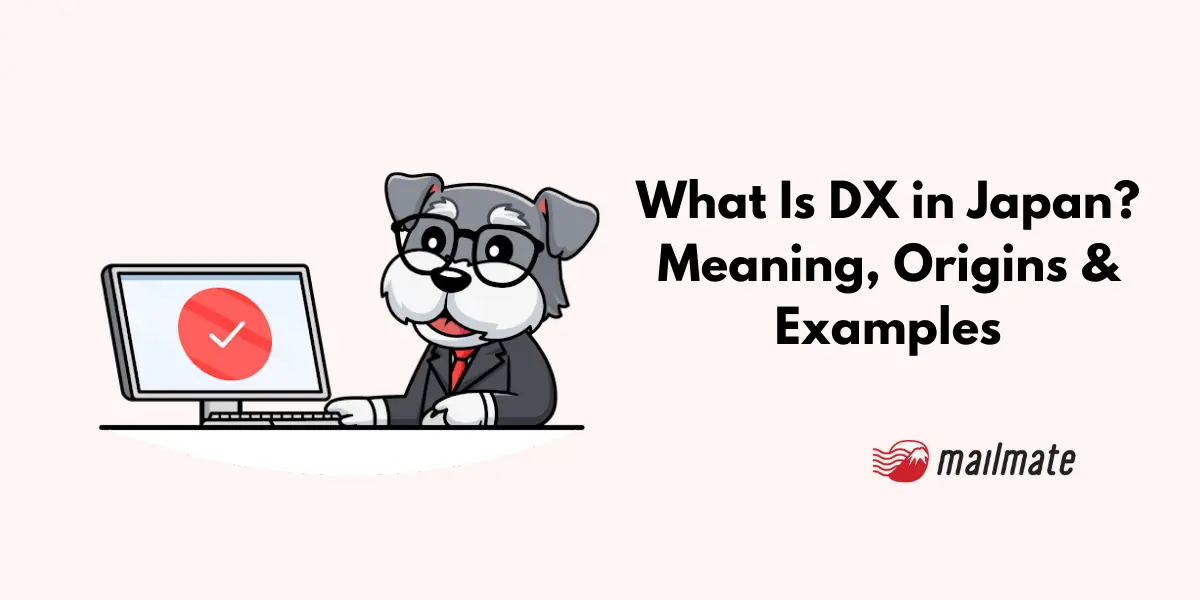What Is DX in Japan? Meaning, Origins & Examples

Everything from your morning mail to your retail experience is getting a digital makeover. At least, that’s the promise.
Here’s the nutshell version of what you should know about DX (digital transformation) in Japan.
What is DX in Japan?
In Japan, the initialism DX stands for Digital Transformation and refers to digital disruption that brings about changes that enhance people’s lives.

Who coined the term DX (digital transformation)?
The term DX is widely attributed to Eric Stolterman Bergqvist, Emeritus Professor at Umeå University in Sweden, who published a 2004 paper describing the concept of digital transformation.
What does the X stand for in DX?
DX is an abbreviation for “digital transformation.” While D stands for digital, the X draws from the Latin root word trans(formation)—meaning “across” or “beyond”—and symbolizes the intersection or crossroads that society is presently facing.

Why is the Japanese government pushing DX?
In 2018, Japan’s Ministry of Economy, Trade and Industry published the 2025 Digital Cliff report that highlighted the necessity of pushing digital transformation forward. The report also covered the human resource issues and economic risks that companies would face if DX were neglected.
Since then, the Japanese government has launched a number of initiatives to promote digital reforms across local governments and the private sector. These initiatives include laws that promote a digital-first approach, the creation of Japan’s Digital Agency, the push toward unanimous use of My Number cards, issuing grants promoting digitalization, etc.
Unfortunately, Japan’s 2022 placement in the Global Digital Competitiveness Ranking was 29th, a backward slide of 7 placements from their 22nd finish in 2018. Japan still has far to go compared to other countries’ digital advances.
Examples of DX in Japan
Corporations and businesses in Japan are encouraged to adopt a digital transformation strategy that will improve business processes and increase profits. Here are some examples of companies that have done so:
MailMate—digitizing postal mail
MailMate is a startup in Japan that digitizes postal mail, making digital copies available via an online dashboard and eliminating the need for a physical mailroom.

Companies can now outsource their mail handling to MailMate’s software, which will save them manhours and physical space and make paper file retrieval as easy as digital.
FamilyMart—unmanned payments
FamilyMart, a major convenience store chain, addressed challenges like operational costs and the need for contactless payments during the coronavirus pandemic by implementing an unmanned payment system.
This system, using cameras and other devices, allows for swift electronic payments by recognizing products in real-time, reducing labor costs, and enabling quicker, contactless shopping experiences for customers.
Kajima Corporation—resolving labor shortages
Facing a shortage of next-generation workers, Kajima Corporation, a major construction firm, adopted AI and robots with a strategy focusing on having half the work done by robots, half of the management done remotely and digitalizing all processes.
The technology Kajima uses enables machines to perform construction autonomously, as demonstrated successfully at a dam site, thereby addressing the worker shortage in the construction industry through digital transformation (DX).
Yamaha Motor—optimizing internal processes
Yamaha Motor, renowned for manufacturing motorcycles, faced operational inefficiencies due to localized optimizations like unique systems at each overseas factory and branch.
To counter this, they initiated top-down awareness reform from management, established a "Digital Strategy Department" with diverse personnel, conducted numerous PoCs annually, and standardized core systems and data usage across locations, leading to reduced manpower needs, enhanced engineering efficiency, and a lower manufacturing defect rate.
Seven & i Holdings—Last One Mile DX platform
Seven & i Holdings, known for its supermarkets and convenience stores, faced challenges in enhancing the efficiency of e-commerce delivery services to deliver new customer value digitally.
To address this, they launched the Last One Mile DX platform, utilizing AI to optimize vehicle/driver allocation, delivery routes, dynamic pricing, and pickup timings, aiming to reduce delivery distances by up to 40%, vehicle usage by about 45%, and enable deliveries in as little as 30 minutes, thus blending real and digital experiences for customers.
In closing
Japan’s digital makeover aims to enhance and simplify processes between residents and local governments and improve economic competitiveness for businesses and corporations.
While there’s far to go before Japan can become on par with other countries leading the way, business owners can learn and benefit from keeping track of businesses that are actively pushing DX in Japan forward.
Spending too long figuring out your Japanese mail?
Virtual mail + translation services start at 3800 per month. 30-day money-back guarantee.

